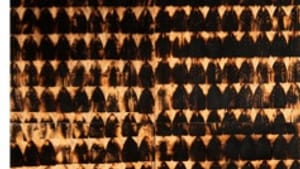Stay in the Loop
BSR publishes on a weekly schedule, with an email newsletter every Wednesday and Thursday morning. There’s no paywall, and subscribing is always free.
Of race prejudice and misunderstanding
'After Tanner' at Pennsylvania Academy (1st review)

Pennsylvania Academy's current "Henry Ossawa Tanner: Modern Spirit," is a fine narrative of this native Philadelphian's life and work. It's almost better that Tanner's best-known works, The Banjo Lesson and The Thankful Poor, are not included; their absence opens the field wider to the full breadth and depth of Tanner's accomplishments.
The exhibit moves chronologically from Tanner's years as a precocious, dutiful student of Eakins and others, through the inevitable search for the right idiom for his talents, to the full expanse of his mature work.
There is shame in the show, the shame of a country that forces an artist of such gifts to flee its provincial racism and spend his productive years elsewhere. Despite his evident star status when he was a student at Pennsylvania Academy, Tanner was apparently never invited to become a faculty member, an oversight that I suspect belongs in the same category.
Big names
One of the best things his alma mater has done, however, is to accompany the Tanner retrospective with an exhibit of contemporary or recent African American artists. Some big names are here: Romare Bearden, Faith Ringgold, Raymond Saunders, Jacob Lawrence, Kara Walker, Betye Saar, William H. Johnson. Many of the rest are still young and building careers; others are less well known than perhaps they should be.
The links to Tanner are patently historical— every minority striver, whatever the category of race or gender, owes a debt to those who persevered through an earlier struggle— but the artistic connections vary in literalness.
Several of the works, including a charming children's illustration by Ringgold, relate a seminal episode in Tanner's life: that fateful day in Fairmount Park, shortly after the end of the Civil War, when the 13-year-old boy spotted a painter at an easel and decided on an improbable career. (The illustration is included in a book, Henry Ossawa Turner: His Boyhood Dream Comes True, on sale at the academy store.)
Social allusions
The works in this exhibit, most from the Academy's collection, vary widely in scope and ambition. The most interesting leave direct references to Tanner behind and go for something bigger and more universal.
The most powerful of these— Branded Irons, by Willie Cole— is a visually arresting composition of black on plywood, scorched into the surface with a household iron. The simple shapes take on layers of historical and social allusions: dark ominous ships, tones of skin, the endless drudgery of someone else's domestic chores.
Glenn Ligon, an art world star with a retrospective at the Whitney Museum on his résumé, is represented by Stranger Drawing #7 (coal dust and pencil on paper, mounted on aluminum), part of a 13-year series based on a James Baldwin essay about being an outsider in a Swiss village where no one had ever seen a black person. Ligon's piece is a page from the essay; the words are there in front of you, but you can't really make them out.
The surface is thick and viscous, strikingly similar to Jasper Johns's encaustic painting, but a deep, complex, midnight black; it pulls you in and keeps you out at the same time. You see but you don't see. It makes a powerful statement of prejudice and misunderstanding.♦
To read another review of "After Tanner" by Anne R. Fabbri, click here.
To read a review of the Tanner exhibit by Anne R. Fabbri, click here.
The exhibit moves chronologically from Tanner's years as a precocious, dutiful student of Eakins and others, through the inevitable search for the right idiom for his talents, to the full expanse of his mature work.
There is shame in the show, the shame of a country that forces an artist of such gifts to flee its provincial racism and spend his productive years elsewhere. Despite his evident star status when he was a student at Pennsylvania Academy, Tanner was apparently never invited to become a faculty member, an oversight that I suspect belongs in the same category.
Big names
One of the best things his alma mater has done, however, is to accompany the Tanner retrospective with an exhibit of contemporary or recent African American artists. Some big names are here: Romare Bearden, Faith Ringgold, Raymond Saunders, Jacob Lawrence, Kara Walker, Betye Saar, William H. Johnson. Many of the rest are still young and building careers; others are less well known than perhaps they should be.
The links to Tanner are patently historical— every minority striver, whatever the category of race or gender, owes a debt to those who persevered through an earlier struggle— but the artistic connections vary in literalness.
Several of the works, including a charming children's illustration by Ringgold, relate a seminal episode in Tanner's life: that fateful day in Fairmount Park, shortly after the end of the Civil War, when the 13-year-old boy spotted a painter at an easel and decided on an improbable career. (The illustration is included in a book, Henry Ossawa Turner: His Boyhood Dream Comes True, on sale at the academy store.)
Social allusions
The works in this exhibit, most from the Academy's collection, vary widely in scope and ambition. The most interesting leave direct references to Tanner behind and go for something bigger and more universal.
The most powerful of these— Branded Irons, by Willie Cole— is a visually arresting composition of black on plywood, scorched into the surface with a household iron. The simple shapes take on layers of historical and social allusions: dark ominous ships, tones of skin, the endless drudgery of someone else's domestic chores.
Glenn Ligon, an art world star with a retrospective at the Whitney Museum on his résumé, is represented by Stranger Drawing #7 (coal dust and pencil on paper, mounted on aluminum), part of a 13-year series based on a James Baldwin essay about being an outsider in a Swiss village where no one had ever seen a black person. Ligon's piece is a page from the essay; the words are there in front of you, but you can't really make them out.
The surface is thick and viscous, strikingly similar to Jasper Johns's encaustic painting, but a deep, complex, midnight black; it pulls you in and keeps you out at the same time. You see but you don't see. It makes a powerful statement of prejudice and misunderstanding.♦
To read another review of "After Tanner" by Anne R. Fabbri, click here.
To read a review of the Tanner exhibit by Anne R. Fabbri, click here.
What, When, Where
“After Tanner: African-American Artists since 1940.†Through April 15, 2012 at Hamilton Bldg., Pennsylvania Academy of the Fine Arts, 128 N. Broad St. (at Cherry). (215) 972-7625 or www.pafa.org.
Sign up for our newsletter
All of the week's new articles, all in one place. Sign up for the free weekly BSR newsletters, and don't miss a conversation.

 Marilyn MacGregor
Marilyn MacGregor